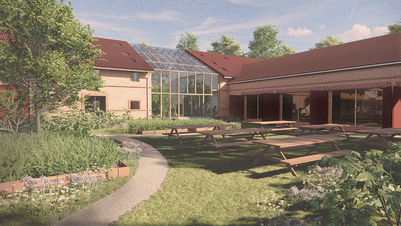
Guest Bloggers XV | Anne-Louise Sommer

Danish Design - Now and Then
“What is Danish design?”. It’s tempting to seek a simple, uniform answer to the question, as Danish design together with design from the rest of Scandinavia, does have its own particular hallmark which sets it apart from all else.
Traditionally, Danish design is known for its quiet, tasteful appeal; an expression of style where materials, functionality and design come together to form a higher sense of balance and harmony. Danish design at its best embodies a unique understanding of textural effect and sensitivity for materials, both of which are amplified by the simplicity and precision of the design itself. Danish design is famed for its democratic, unpretentious expression; simple, effortless, yet refined.
Having said this, it should be noted that Danish design covers a wide range of art forms, from furniture design to architecture and functional design, from industrial design to fashion, textile design and ceramics. Today the design field is large and broad, encompassing both the traditional, object-based design concept and the new, so-called expanded concept of design, which includes immaterial design: strategic design, service design and concept design as sources of design solutions. In that sense, design is pervasive, touching on all aspects of life. And obviously, it also includes welfare design, which covers everything from medico-technical products to user solutions in public administration.
This broad field of Danish design in the 21st Century reveals a true diversity of influences and attitudes toward design itself; a design constantly under modification, born out of the melting pot of domestic tradition and innovation from abroad.
In Denmark, we have a long tradition for close links between design, social development and culture. A consistent political emphasis on quality design and form-giving has been a key element in the development of the Danish welfare society throughout the 20th century. Even in times with dramatic economic setbacks and social challenges, as in the interwar years, design has been prioritized as an important value-building factor, as exemplified in the innovative residential and school architecture at the time. The Danish government has never invested more heavily in design than in the 1920s and 30s, and this reflected a unique priority. There was a willingness to invest in design. Residential complexes and healthy and affordable homes were built for the working class, and all the public buildings – schools, city halls and libraries – were equipped with quality design: PH lamps and high-quality Danish furniture design. There has always been, and still is, a general awareness of the value of providing a quality physical setting for living, surrounded by quality furniture and utilitarian objects, and an awareness that design was a means of realizing the ‘dream of the good life’. This awareness also reflected the belief that good and humane surroundings create good citizens.
This specific design awareness has taken root in Denmark over generations, across social classes. That is our common ground, the gift that we are endowed with from birth, and as such it is ubiquitous. Virtually all homes have some quality design objects. And all Danes have gone to schools equipped with furniture that reflects good design or used day care facilities furnished with design classics of an often iconic character. When we enter the public space the furnishings in the urban space are consistently of a high quality, and the same is true of signage, station buildings, the metro and Copenhagen Airport. In Denmark, we have a unique tradition for including design on every scale. This means that all Danes have grown up with daily, easy and unrestricted access to good design.
To define Danish design culture more specifically, a key feature is the emphasis on quality and sustainability in the sense of design that is durable, anchored in tradition and identity-building. Danish design is rarely intended as “high-end” design but has a toned-down expression and a genuine and unpretentious appearance. Another key concept in Danish design is “formålstjenlighed” – the quality of serving a particular purpose. This is not purely about function; it also means that design accommodates people and frames the meeting between person and object. “Accessibility” is another key concept, which clearly addresses the meeting between user and object. For something to be accessible, it has to be accessible to everyone. This means being approachable, offering quality to everyone, being inclusive. In 1960, Viggo Sten Møller, then rector of the School of Arts and Crafts in Copenhagen, said that Danish furniture had “… attained a level which places home furnishing of functional design and high aesthetic quality within the means of the average consumer. Such a ‘social-aesthetic’ balance is an important asset to a people,” was his conclusion. He argued that Denmark was a country sprung from a Social Democratic tradition, which essentially provided good conditions for most of its citizens – and that from this basis sprang the ideal of the democratic People’s Furniture. He saw the social cohesion that came from this shared cultural legacy as a crucial asset in the general emphasis on improving the aesthetics of private as well as public spaces. And he was convinced that the achievement of this effort to balance social and aesthetic goals would be highly beneficial to society, as it would make the country a better place to live for everyone.
Talking about the idiom of Danish design it’s possible to detect a purified type of expression. A minimalist style that combines elegance with a quest for the pristine, and a hyperaesthetic approach with an ethical foundation growing out of ecological awareness and a feeling for the good material. In furniture design the inspiration is clear. It’s global in its take. Even the designers of today draw equally on the ascetic North American Shaker style, on the delicate Japanese tradition, and not least Nordic design, which throughout this century has paid its dues with the human starting-point typified by simplicity and quality. Contemporary design in Denmark encompasses the best of an international tradition, but we are far from the intricacies of the postmodern cabinet of curiosities, for while the inspiration may come from many sources, the fundamental tone is subdued. It is not so much a matter of geographical origin as an outlook on life, and a sense of responsibility towards both the individual and the community. In that sense it’s still a matter of lifestyle, whether the body is wrapped in ecological cotton or the television is made of recycled materials.
In the 21st century, the dream has taken on a different character in tune with general development trends, but the designer’s work continues to hold idealist potentials and the belief that design is capable of improving living conditions for individuals as well as society. This is evident in the world’s most prestigious design award, the Danish INDEX: Award, which is handed out under the motto “Design to improve life”, and which contributes to Denmark’s global lead position in the field of design. INDEX: Award is an excellent example of young designers picking up the gauntlet and taking action to find answers to the global community’s ‘grand challenges’.
Design enhances products that may not at first glance seem design-related. Design processes and design thinking have the capacity to improve production processes in a broad sense, service design has the capacity to improve the public administration’s user contacts and services, and strategic design has the capacity to optimize marketing efforts for any product. Understanding the full potential of design is therefore a major asset in a social, a commercial and a cultural context. Looking back at tradition and history and learning from it can help us act proactively and with an eye on the future. That is why it still makes sense to explore the potentials of design history.
Today it is well known that design is a competitive parameter for companies. Denmark is a global leader regarding design companies, and Danish Design is an internationally recognized brand. In the 21st century, the popularity of that brand is continuing to grow. The design field is large, broad and pervasive, encompassing both the traditional, object-based design concept and the new, so-called expanded concept of design, which includes immaterial design: strategic design, service design, concept design and welfare design as sources of design solutions.
Today it is well known that design is a competitive parameter for companies. Denmark is a global leader with regard to design companies, and Danish Design is an internationally recognized brand. There is a huge potential here, and the story about Denmark as a design society where a design understanding has been internalized over generations, contributing to a cohesive society, is a strong story. A genuine and persistent priority on design in every aspect of society is a tremendous value-building factor. Especially if it has a social agenda, is inclusive and applies a broad perspective.
Anne-Louise Sommer is the museum director of Designmuseum Danmark and adjunct professor at the University of Southern Denmark.















